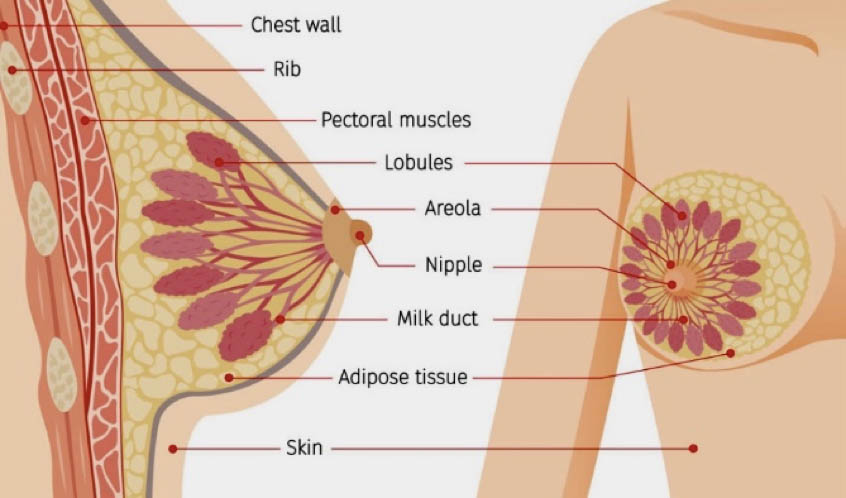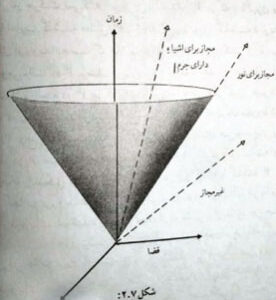By: Prof. Dr. Seyed Saeid Zamanieh Shahri, MD and Prof. Dr. Sonia Sayyedalhosseini, MD
Breast cancer: Breast cancer is a type of cancer that disrupts the function of cell division in breast cells. Breast cancer cells multiply uncontrollably and more than necessary in an infected person. There are different types of breast cancer. Its type depends on which type of breast cells are affected. This cancer may start from different parts in the breast.
The breast has three general parts:
Lobules: Lobules are glands where milk is made. Ducts: Ducts are tubes that carry milk from the lobule to the nipple. Connective tissue: Lymphatic tissue and fat tissue that covers and holds other parts of the breast together. Most breast cancers start in the ducts or lobules. Cancer cells can travel out of the breast through the blood vessels and lymphatic channels and spread to the rest of the body, which we say that the cancer has metastasized.
Anatomy and physiology: In examining the structure and function of the breast, we discuss the anatomy of the breast. The mammary gland is made of lobules. The lobules drain into the duct system and connect the mammary ducts. There are fat and connective tissue between the gland tissue and ducts. There are no muscles in the breasts, but there are muscles under each breast that cover the ribs. Blood vessels and lymphatic vessels are located in the breast. The lymphatic vessels in the breast drain to the lymph nodes in the armpit and behind the sternum.
Areola: In women, milk comes out of the breast at the nipple, which is surrounded by a dark area of skin called the areola. The areola contains small, modified sweat glands known as Montgomery tubules. These glands secrete fluids to soften and lubricates the nipple during breastfeeding.
Each breast has 15 to 20 lobes that radially surround the nipple. Inside these lobes there are smaller parts called lobules. At the end of each lobule are small ducts that produce milk. These structures are connected by small tubes called ducts, which carry milk to the nipples. Fat fills the space between the lobes and ducts. Also, each breast contains blood vessels and vessels that transport lymphatic fluid. Lymph is a fluid that passes through a network of channels called the lymphatic system.
Lymphatic vessels lead to lymph nodes. Lymph nodes are located in the armpit, above the groin, and in the chest. Cancer of these nodes indicates that cancer cells have spread to other parts of the body. Lymph nodes are also found in many other parts of the body, including inside the chest, abdominal cavity, and groin. The growth and function of the breast depends on the hormones produced by the ovaries, namely estrogen and progesterone. Estrogen lengthens the ducts and causes side branches.
Progesterone increases the number and size of lobules in order to prepare the breast for breastfeeding. After ovulation, progesterone causes breast cells to grow, and blood vessels to enlarge and fill with blood. At this time, the breasts are often filled with fluid and tender and swollen.
Breast tissue is surrounded by a thin layer of connective tissue called fascia. The skin that covers the breast is similar to the skin of the rest of the body with sweat glands, hair follicles and other skin characteristics. During a breast examination, the doctor examines the skin in addition to the breast tissue itself. The structure of the male breast is almost identical to that of the female breast, except that male breast tissue lacks specialized lobules, as there is no physiological need for the male breast to produce milk. Abnormal enlargement of male breasts is medically known as gynecomastia.
In women the breast is an organ whose structure reflects its special function, which is to produce milk for breastfeeding.
Risk factors:
۱) Immutable risk factors that affect the incidence of breast cancer: being a woman and getting older are two very important factors. Events such as genetic mutations during life are another important factor.
The date of the start of period (for the first time = early menarche) and its end (menopause) have an effect on the occurrence of breast cancer. The lower the age at which the period starts and the older the age at the end, the higher the chance of getting cancer.
The history of breast cancer in the family or the person himself (previously) increases the probability of getting infected.
There are other non-cancerous diseases related to the breast, which increase the possibility of infection.
Being under the radiation therapy and the use of diethylacetylbestrol by the person (or by his mother during pregnancy) are also two effective risk factors.
۲) Modifiable risk factors that affect the occurrence of breast cancer:
Overweight and obesity (especially after menopause) Inactivity and not exercising Use of female hormones (for contraception and alternative treatment after menopause)
A history of pregnancy without delivery
Giving birth after the age of 30 and not breastfeeding the baby until then
Consumption of alcoholic beverages and tobacco Considering that the above category of risk factors is somewhat under our control, we can reduce the possibility of risk by staying away from them.
Pathophysiology: A change in DNA or a mutation in its gene can cause normal breast cells to turn into cancer cells. Some changes are passed down from parents (inherited) and can increase the risk of breast cancer. Other lifestyle factors, such as what you eat, how much you exercise, etc., can increase your risk of developing this cancer. But it is not yet known exactly how some risk factors cause normal cells to become cancerous. Hormones seem to play an important role in many cases of breast cancer, but how this happens is still not fully understood.
In general, the following causes of cancer can be listed:
Genetic changes or mutations: Some mutations are inherited or passed on from parents. This means that when you are born, mutations are present in all your cells. Certain mutations can greatly increase the risk of certain cancers.
Proto-oncogenes: Proto-oncogenes are genes that help cells grow normally. Proto-oncogenes become bad genes when they change or multiply uncontrollably, and if they get out of control, they can lead to cancer. This bad gene is called an oncogene. Tumor suppressor genes: These are genes that slow down cell division. If these genes do not work properly, they can lead to cancer. Inherited gene changes: Some inherited mutations dramatically increase the risk of developing cancer, leading to cancers that run in families.
Acquired gene changes: Mutations in breast cancer often occur during a woman’s lifetime rather than being inherited, which may be caused by radiation or chemicals.
Signs and symptoms of Breast Cancer: In many cases, breast cancer is diagnosed before symptoms appear; Whether by finding any abnormality in the mammography test or finding a lump in the breast. The formation of a mass under the armpit or above the collarbone that does not go away can be a sign of breast cancer.
Some other symptoms are: discharge from the breast, indentation of the nipple, changes in the skin of the breast and seeing signs such as redness, changes in texture or wrinkling of the skin of the breast.
Since not all lumps are cancerous, they should be carefully examined by a doctor. Knowing what the breasts should look like is an important part of breast health.
Although it is important to have regular screening tests to detect this cancer, mammograms do not find every type of breast cancer. Therefore, it is very important to be aware of your breast changes and know the signs and symptoms of breast cancer. The most common symptom of breast cancer is the presence of a new mass. A painless hard lump with irregular edges is more likely to be cancerous, but breast cancer lumps can also be soft or round. They can even be painful. It is very important to have any type of lump or changes in the breast checked by a specialist.
Other possible signs of breast cancer: swelling of all or part of the breast (even if no lump is felt), Pitting of the skin (sometimes looks like orange peel), breast or nipple pain, nipple indentation, redness, scaling or thickening of the nipple or breast skin, nipple discharge, swollen lymph nodes (sometimes breast cancer can spread to the lymph nodes under the arm or around the collarbone and cause a lump or swelling, (even before the main tumor in the breast is large enough to be felt).
Although any of these symptoms can be caused by other things than breast cancer, if they are present, you should see a specialist doctor to find out the cause. Note that screening tests help to detect breast cancer as quickly as possible before any symptoms appear and give you a better chance of treatment.
Diagnosis: Breast cancer diagnosis is done in several steps, including: physical examination of the breast, mammography test or and finally biopsy.
Mammography: It is a diagnostic test that determines the nature of the mass. But since it can give false results, other diagnostic tests will be performed.
Ultrasound: It is one of the tests that provides images of the inside of the breast tissue to the doctor and shows whether the lump is cancerous or non-cancerous.
Biopsy: It is a definitive method to diagnose the cancerous mass. To perform this test, a small tissue sample is taken by inserting a needle into the breast and will be sent to the laboratory for further examination.
Causes of breast cancer: In many cases, a person with breast cancer does not have any family history or risk factors affecting the occurrence of this cancer. Among the risk factors effective in the occurrence of breast cancer, the following can be mentioned:
Gender: Breast cancer is more common in women.
Age: The risk of breast cancer increases with age.
Family history of breast cancer
The onset of menstruation at a young age or menopause at an advanced age increases the risk of breast cancer. Women who use contraceptive methods after the age of 30 and do not have children are more susceptible to breast cancer. Using birth control pills also increases the chance of getting this cancer.
Life style: Obesity, overweight or consumption of fatty foods increase the risk of breast cancer.
People who drink a lot of alcohol are more prone to breast cancer.
Regular exercise is one of the measures that reduce the risk of breast cancer.















